An easy authentic japchae noodle recipe (Korean glass noodles stir fry) made with perfectly chewy glass noodles, seasoned lightly with sweet and savory japchae sauce, toasted sesame oil, and a variety of vegetables, and made without boiling the noodles.
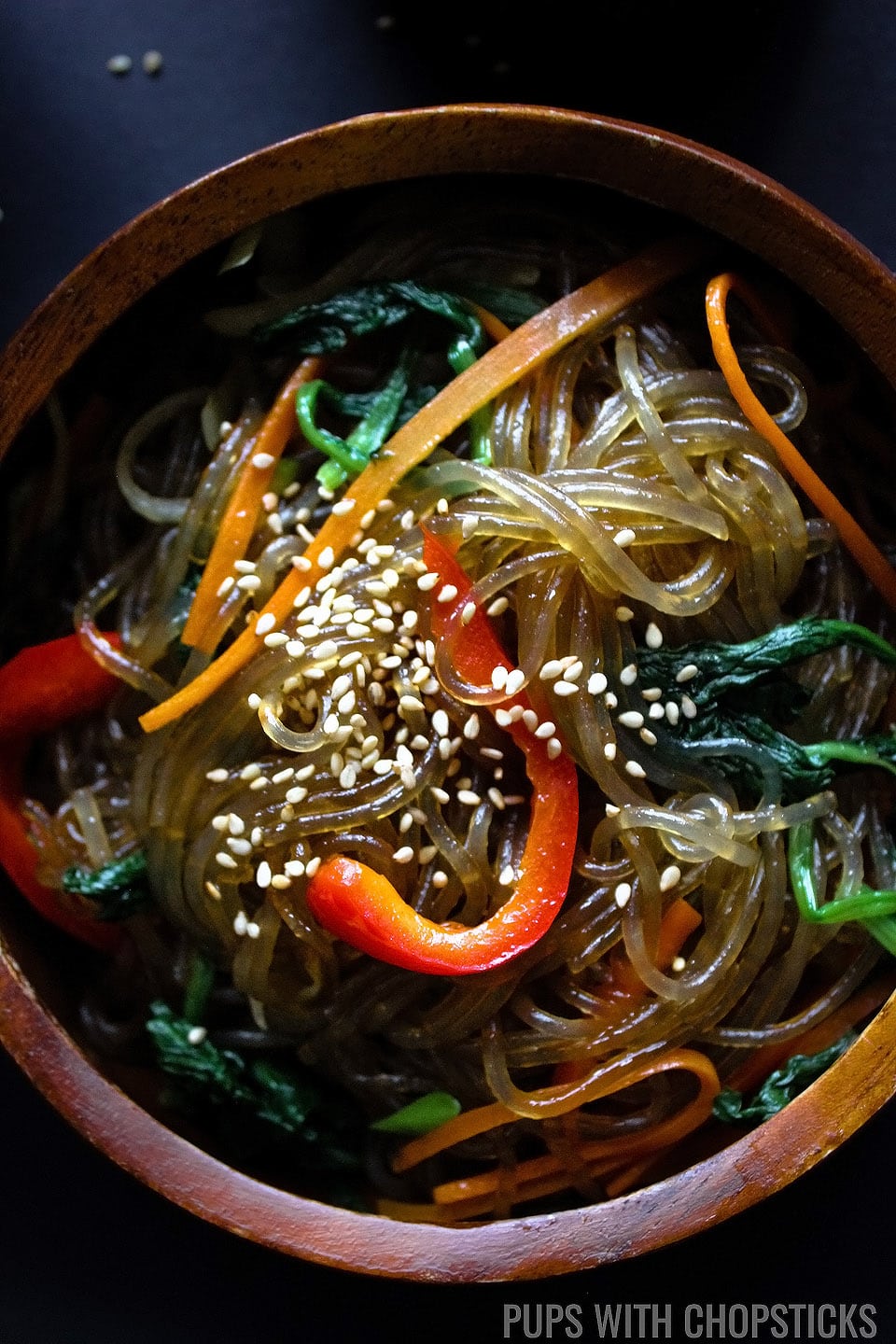
Table of Contents
- What is Japchae?
- Why You Will Love This Korean Glass Noodle Recipe
- Ingredients for Japchae
- What are Clear Korean Glass Noodles?
- How to Get Springy (Not Mushy) Korean Glass Noodles
- How to Make Japchae
- How to Serve Korean Glass Noodles
- Storing and Reheating
- FAQs
- Looking for More Korean Recipes? Try These!
- Recipe Card
- More Noodle Recipes You May Like
What is Japchae?
Japchae (잡채) (aka chap chae) is a very popular stir-fried Korean glass noodle dish that is typically a side dish (banchan) but it can also be eaten as a main dish as well and served with a bed of rice.
Similar to the chewy texture of tteokbokki, japchae is made of a combination of springy, chewy, and incredibly flavorful glass noodles with a variety of colorful vegetables cooked in a sweet and savory sauce.
This is a vegetarian chap chae recipe and does not contain any meat in it, but you can easily add some chicken, beef, or pork to this recipe easily by pre-frying some and mixing it in at the very end.
Whenever I bring this japchae dish to any potlucks, parties, or BBQs they are always a hit, so if you're looking for something to bring to a BBQ gathering, you should definitely consider this dish. It's easy to make ahead and reheat in the microwave the next day.

Why You Will Love This Korean Glass Noodle Recipe
- I streamlined the process of this chap chae recipe so that you will not have to boil the noodles in water. The result makes perfectly springy and chewy noodles so that you don't need to worry about overcooking them.
- Since the noodles will not be fully cooked from the soak, the sauce (which has extra water) will fully cook the noodles all the way through while you are stir-frying. This will let the noodles absorb even more sauce into it which will give them even more flavor.
- The sweet and savory japchae sauce is delicious and gets fully absorbed right into the noodles since the noodles are not boiled.
- It's quick and easy and can be made all in one large pot or frying pan.
Ingredients for Japchae
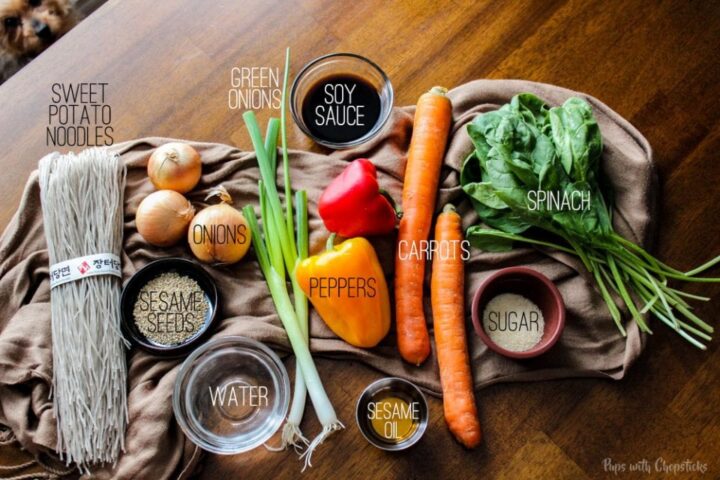
- Egg - Plain omelet cut into thin ribbons, or if you're pressed for time, quickly scramble the egg and set it aside to add at the end when you are mixing the noodles
- Peppers - I like to use yellow, orange, or red bell peppers for their sweeter flavor.
- Shiitake Mushrooms - I like to cook these ahead of time in a sweet soy sauce, and then cut them into thin slices
- Meat - This is not a traditional ingredient, but I have added in leftover meats in the past for a heartier noodle dish. If you choose to keep it vegetarian, you can just skip adding the meat.
- Garlic - Adds a bit of extra flavor, but I like to keep this optional because it can overpower the dish.
- Vegetables - I like to stick to the basic vegetables which are carrots, onions, green onions, spinach, and peppers
- Soy Sauce, Sugar, and Toasted Sesame Oil - This trio is what makes the delicious sweet and savory japchae sauce.
- Sesame seeds - For more flavor, garnish this Korean noodle dish with lots of toasted sesame seeds
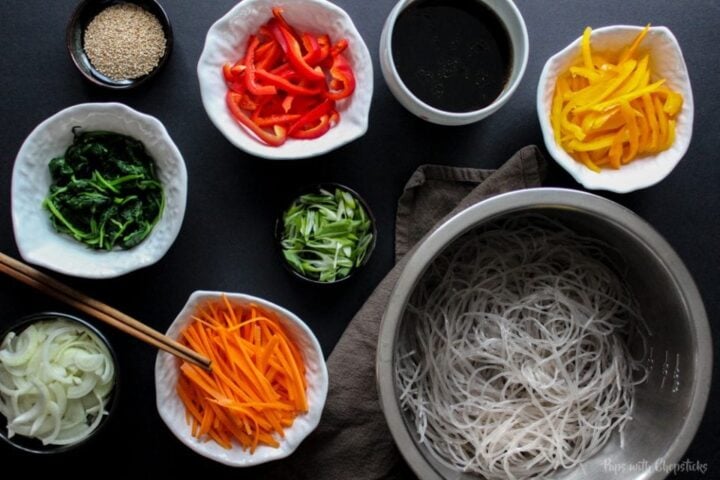
What are Clear Korean Glass Noodles?
The noodles used in Japchae are called Korean glass noodles (dangmyeon 당면). They are a type of Korean vermicelli made with sweet potato starch. These sweet potato starch noodles are thicker than your typical Asian glass noodles and are about 2 mm thick in diameter.
When sweet potato noodles are cooked, they turn into clear and shiny noodles with a springy and chewy texture when they are not overcooked.
They do not contain any wheat so they are a good option for any type of gluten-free diet and they are very delicious because they are fantastic at soaking up sauces which makes them incredibly flavorful.
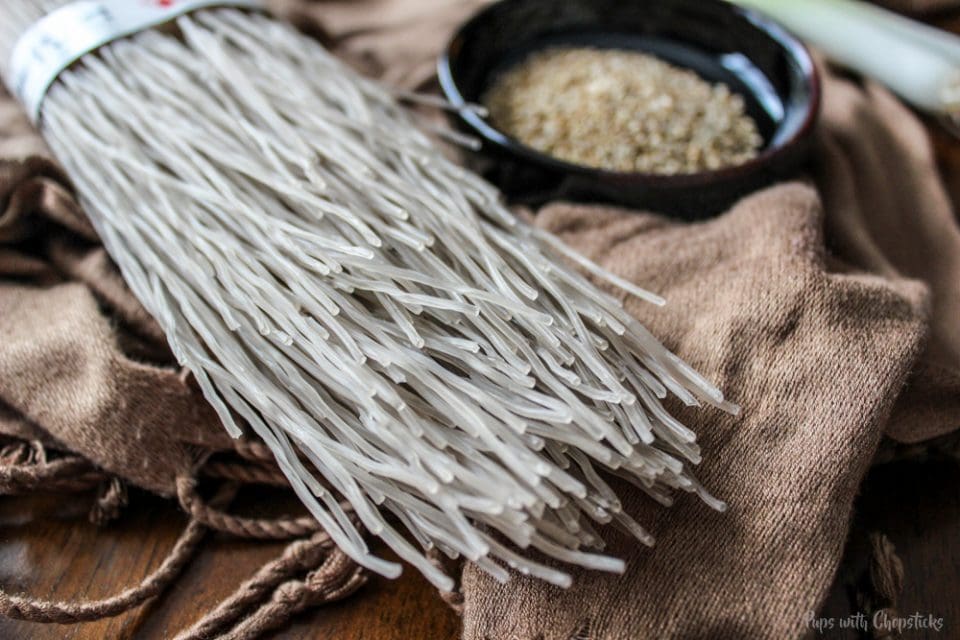
How to Get Springy (Not Mushy) Korean Glass Noodles
- On almost every noodle packaging instruction that I found, they always teach you to boil the noodles first. Don't do it! 🙂 Seriously.
- What I found worked amazingly was just soaking the noodles for 20 mins in warm to hot water. I just used hot tap water for simplicity but make sure to run the tap until the water is hot. No need to boil the noodles in a pot or rinse them afterward.
- I found boiling the noodles in a pot, agitated the starches too much and it kept the water at a constant boiling point which would usually overcook the noodles on the outside but still had raw centers - the result would be mushy noodles. Soaking in hot water softens the noodles evenly through
- Soaking the noodles in a large mixing bowl created soft and pliable noodles but they will still be slightly raw. When I cook the noodles directly in a large pot with the vegetables, I mix in a bit of water to the japchae sauce to cook the noodles all the way through with the sauce - this will absorb more of the sauce directly into the noodles and will make it much more flavorful.
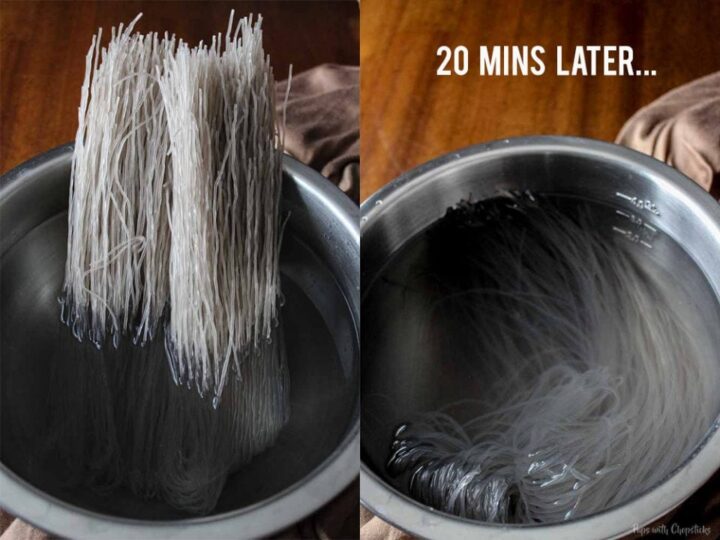
How to Make Japchae
- Preparation is important for this dish, so you will have to pre-cut all the vegetables ahead of time. You can use this time to also soak the noodles in warm to hot tap water while you are preparing the vegetables and making the japchae sauce.
- There are a lot of ingredients in this dish, so make sure you use a large frying pan for this.
- First, I cooked all the vegetables together for about 3-5 mins until they were soft and then I transferred them out of the pan to another bowl and set it aside for later.
- Once the noodles were soft, I would drain the water out of the boil and cut them into 4-inch length pieces. I cooked the noodles, with half the soy sauce mixture and when the noodles were almost cooked (they will look shiny and translucent), I added the vegetables back into the frying pan and added the other half of the soy sauce mixture.
- ...and voila! 🙂 You're done! Time to enjoy your chewy Korean Glass Noodles (Japchae / ChapChae)!
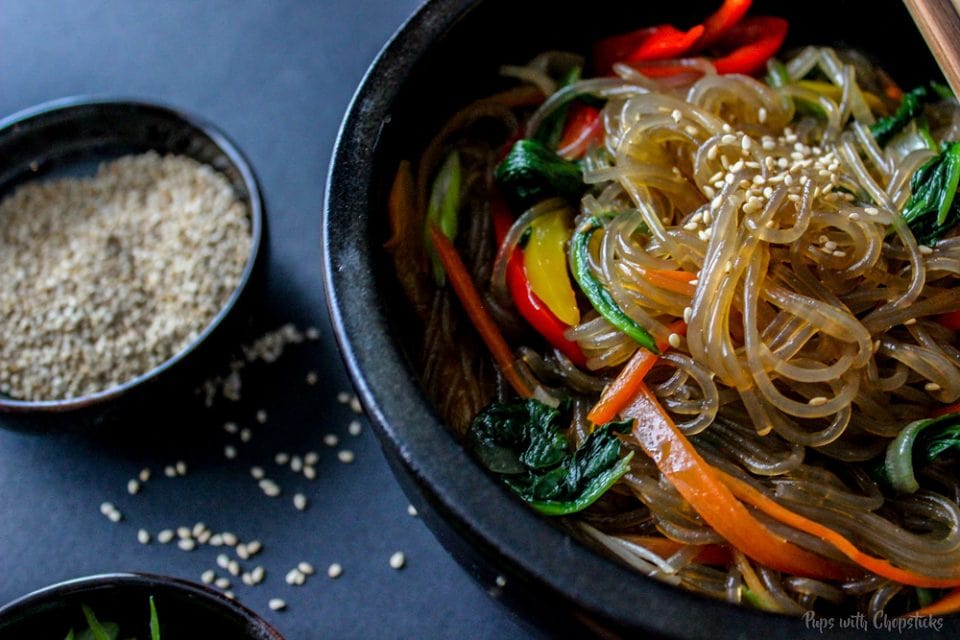
How to Serve Korean Glass Noodles
- Eat them As-Is - They are absolutely delicious as is as a main dish! I like to serve them warm or at room temperature. I don't recommend serving them cold, since the noodles won't be as chewy and tend to be harder.
- As a Side Dish (Banchan) - They also go great as a side dish with Korean fried chicken, Korean Tofu Stew, Spicy Korean Pork Bulgogi, or mixed in with Tteokbokki.
- Mixed in with Rice - It seems a bit odd, but I love mixing it with my Tuna Mayo Rice Bowls, and Kimchi Fried Rice as well to give it a bit more texture and chewiness.
Storing and Reheating
Once you put these glass noodles in the fridge, the noodles will get hard from the cold so you can't serve them straight from the fridge.
To reheat japchae noodles, put them in the microwave for one minute at a time, (for up to a few minutes) while mixing them with a utensil in between minutes to prevent cold spots. Mixing and using small time intervals, will prevent the noodles from getting too hot too quickly which can melt its delicate texture springy texture.
You can store this in the fridge for up to a week.
FAQs
Japchae tastes best either hot or at room temperature (warm/cooled). Once the noodles are refrigerated and get cold, they will turn hard and I personally find they don't taste as good.
Yes, it is! Japchae is with Korean sweet potato noodles (dangmyeon 당면) made with sweet potato starch.
It tastes like stir-fried vegetables with soft springy noodles that are seasoned with sesame oil and a sweet and savory soy sauce.
Yes, they are gluten-free! They are made with sweet potato starch which contains no gluten.
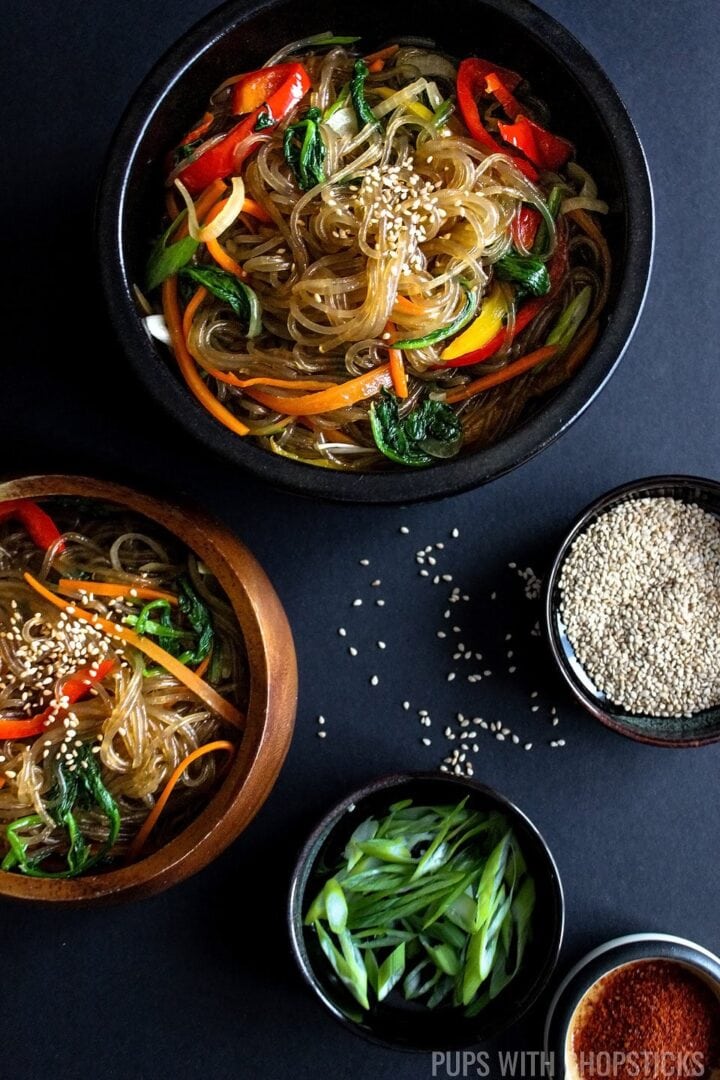
Looking for More Korean Recipes? Try These!
- Korean Corn Cheese (Elote Style)
- Spicy Korean Pork Bulgogi
- Spicy Soondubu Tofu Stew (Soondubu Jjigae)
- Stir-Fried Kimchi Rice Cakes
- Korean Fried Popcorn Turkey
- Tteokbokki (Korean Spicy Rice Cakes)
- Korean Cucumber Salad (Oi Muchim)
- Korean Tuna Mayo Rice Bowl (Tuna Mayo Deopbap)
- Kimchi Fried Rice
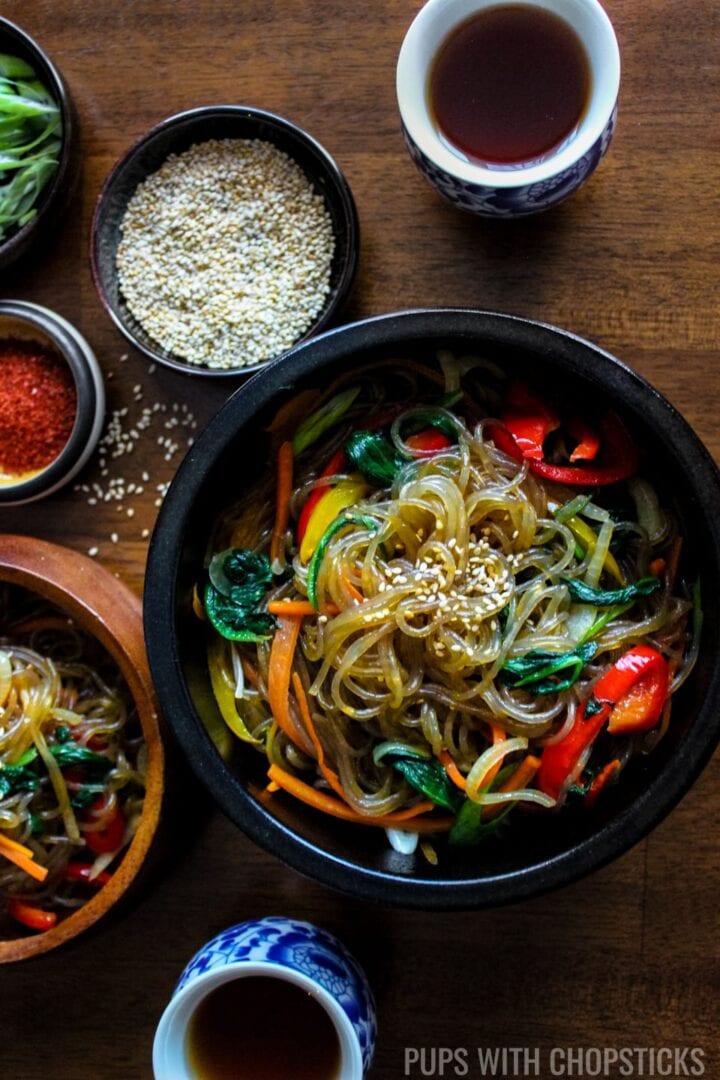
If you like my recipes and want to be updated on when new ones come out, please consider subscribing to my newsletter (we don't spam) and follow along on Instagram, Facebook, and Pinterest for all of my latest recipes!
Recipe Card
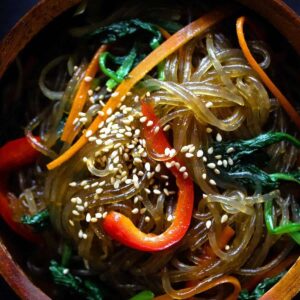
Easy Japchae Recipe (Korean Glass Noodles Stir Fry)
Joyce's Recipe Notes
- Reheating Leftovers - Once you put these glass noodles in the fridge, the noodles will get hard from the cold so you can't serve them straight from the fridge. Re-heat it in the microwave for one minute at a time, (for up to a few minutes) while mixing it with a utensil in between minutes to prevent cold spots. Mixing and using small time intervals, will prevent the noodles from getting too hot too quickly which can melt its delicate texture springy texture.
- Storing - You can store this in the fridge for up to a week.
Ingredients
- 400 g sweet potato noodles
Japchae Sauce
- ½ cup hot water
- ¼ cup sugar
- ½ cup soy sauce
- 2 tablespoons sesame oil
Vegetables
- 1-2 carrots (cut into matchstick slivers, approximately 1 ½ cups)
- 1 bundle spinach (approximately 1 cup after it has been cooked and wilted)
- 1-2 peppers (sliced into thin strips, approximately 1 ½ cups)
- 1 onion (medium-sized, sliced, approximately 1 cup)
Toppings & Garnishes
- 2 stalks green onion (finely chopped)
- toasted sesame seeds
Instructions
Preparing the Sweet Potato Glass Noodles and Vegetables
- In a large bowl, add warm to hot tap water and soak the noodles in it for 20 mins. Prepare the vegetables while you are waiting for the noodles to soak.
- Peel the carrot and cut them into thin matchstick sizes. Set aside.
- Slice the onions and peppers. Set aside
- Boil the spinach for 2 mins. Once it is done, run it under cold water to stop the cooking process and squeeze and squeeze all the water out. The texture should be dry and not soggy. Season it with salt and set it aside. Alternatively, you can also skip boiling the spinach and put it directly in with the rest of the vegetables to save some time.
- Toast sesame seeds in a frying pan on low heat until brown. Set aside.
- Finely chop the green onions and set them aside for the end.
- After 20 mins, when the noodles are soft and pliable, drain the water out and cut them roughly 4 inches in length. Set it aside for later.
Make the Japchae Sauce
- In a small bowl, dissolve ¼ cup sugar with ½ cup hot water. Then add in ½ cup soy sauce and 2 tablespoons sesame oil. Set it aside.
Cooking the Japchae
- In a large non-stick frying pan, add oil and set the heat to medium.
- Once the oil has warmed up, add in the veggies (except the green onions) and cook them for approximately 3-5 mins or until the vegetables are soft. Remove them from the pan into a dish and set it aside.
- Add the noodles to the pan and half the soy sauce mixture and cook for about 2-3 mins. Keep flipping the noodles, until they are transparent and glossy and no longer translucent.
- When the noodles are almost done, add the vegetables back in and add in the remainder of the soy sauce mixture and cook for another 1-2 mins.
- Turn off the heat and add in the green onions and sesame seeds and mix well. (It's might be easier to mix it with your hands)
- Enjoy!
Nutrition
*Nutritional information is calculated using online tools and is an estimate*
Disclaimer: We are a participant in the Amazon Services LLC Associates Program, an affiliate advertising program designed to provide a means for us to earn fees by linking to Amazon.com and affiliated sites. I always appreciate the support but please try to buy your items locally if possible to support your local shops (they would most likely be cheaper locally as well!)


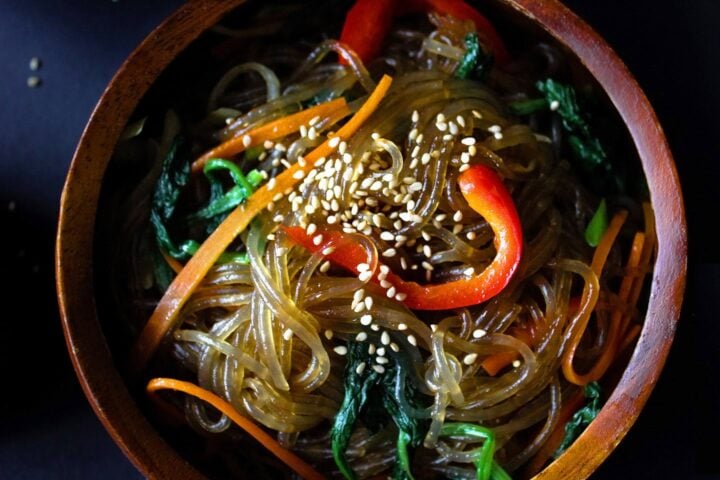
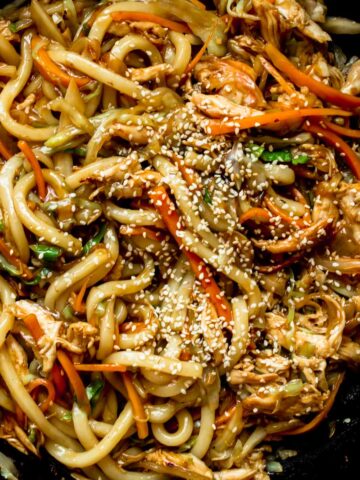
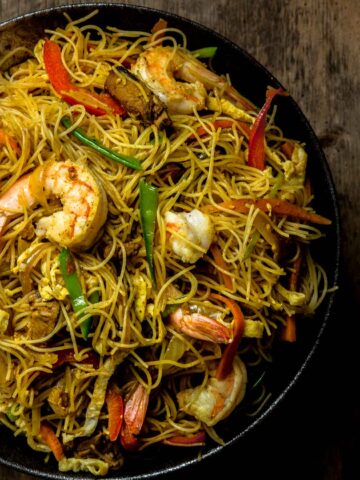
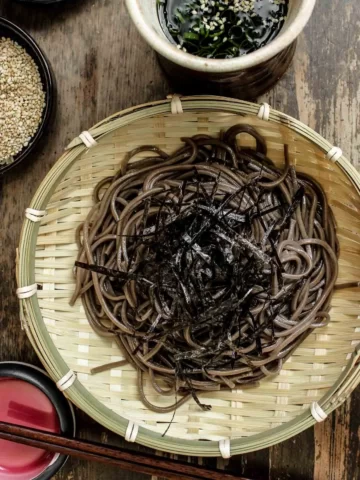
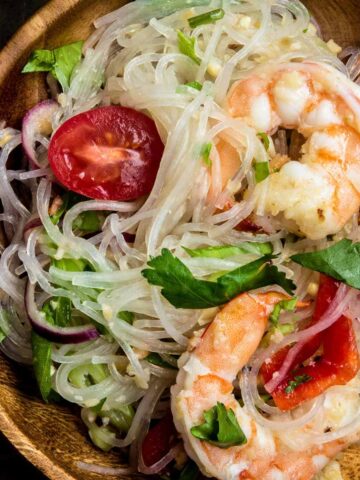
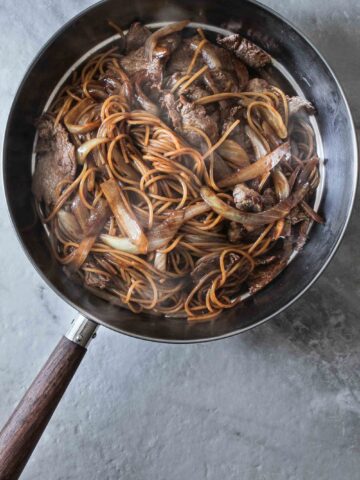
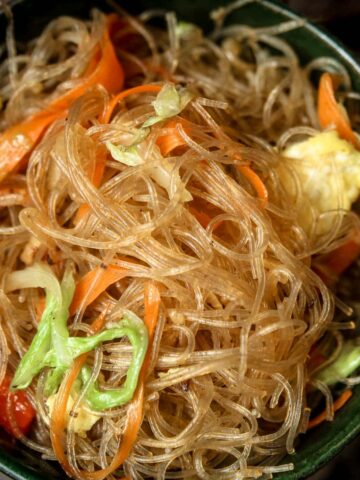

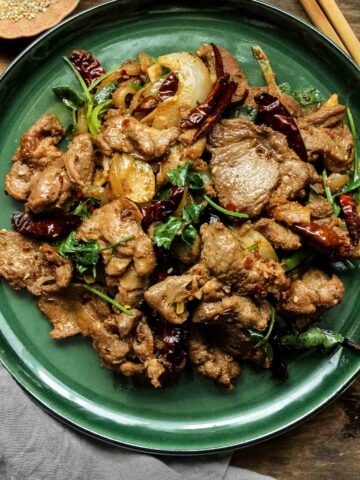
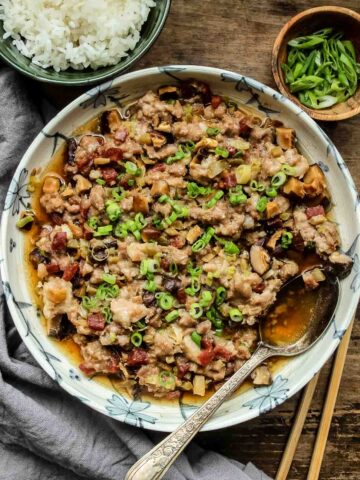
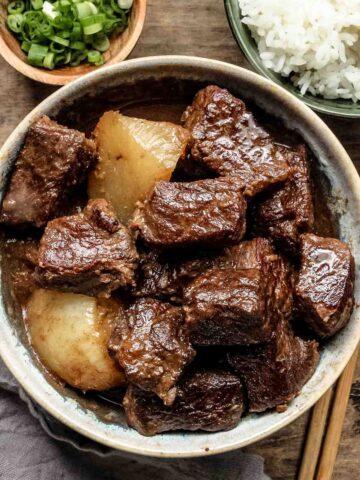
Sokha says
Hi Joyce! I was hoping to make this for my family tomorrow, but only have wide sweet potato noodles (about half an inch wide) on hand. Would you suggest soaking it longer than 20 minutes to get the desired texture or is this type of noodle for a different type of dish altogether?
Joyce Lee says
Hi Sokha!
Yes you may need to soak the noodles a bit longer for those type of noodles to work. I would soak them until they are pliable and you can easily wrap the noodles around your finger without breaking them.
When you add them to the pan to cook, you may also need to add a bit of water to give it a head start in cooking. How much water to add will depend on how much noodles you are using but I would add the water in one tablespoon at a time until the noodles start to become clear in color.
I would also try to do a taste test before you add the sauce to test how cooked the noodles are after you add the water to cook it a bit in the pan.
Once you are happy with the texture, then add in the sauce to cook it all the way. Keep in mind that if you find the noodles are still tough and hard after you add the sauce and have fully cooked it, you can still add a bit more water to further soften the noodles 🙂
Hope this helps!
Sokha says
Thanks so much for your detailed reply, Joyce. I will give this a try and let you know the results! 🙂
Lily says
So good! I halved the noodles and doubled the veggies but I forgot to lesson the sauce. Still amazing and look forward to perfecting my technique. Thank you so much for this yummy and perfectly chewy recipe 🙂
Joyce Lee says
Hi Lily!
I'm so happy you liked it! The chewy noodles are definitely my favorite part too 🙂
Jessie says
Thank you so much for this recipe. I love japchae, but I have almost no experience cooking this type of food, plus I hate adding vegetables one at a time AND boiling noodles, keeping track of a million things. This was perfect and tasted exactly like the japchae I ate in a restaurant that turned me onto it.
I used baby spinach and added it right with the rest of the veg. I also used toasted black sesame seeds. Delicious.
Joyce Lee says
Hi Jessie!
Yay! I'm so happy you liked it! Don't worry, I hate boiling noodles too! haha I hate cleaning pots which is why a lot of my recipes soak the noodles in hot water instead of boiling them. 🙂
Ieva says
Just made this recipe for dinner, as we had all the ingredients already at home! So simple and so delicious! Thanks for the recipe!
Jess says
I love that you don't have to boil the noodles!